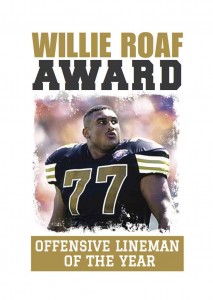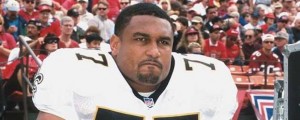Pine Bluff native and NFL Hall of Famer, Willie Roaf, has been named to the 2014 College Football Hall of Fame.
The official announcement:
IRVING, Texas (May 22, 2014) – The National Football Foundation & College Hall of Fame announced today the 2014 College Football Hall of Fame Class, which includes the names of 14 First Team All-America players and two legendary coaches. The inductees were selected from the national ballot of 75 All-America players and six elite coaches from the Football Bowl Subdivision and the 87 players and 26 coaches from the divisional ranks. PrimeSport, the leader in providing direct access to the biggest sporting events on the planet, served as the official presenting sponsor of the announcement, which took place at the Omni Mandalay Hotel at Las Colinas in Irving, Texas.
2014 COLLEGE FOOTBALL HALL OF FAME CLASS
Players:
- DRE BLY – DB, North Carolina (1996-98)
- TONY BOSELLI – OT, Southern California (1991-94)
- DAVE BUTZ – DT, Purdue (1970-72)
- SHANE CONLAN – LB, Penn State (1983-86)
- JOE HAMILTON – QB, Georgia Tech (1996-99)
- JOHN HUARD – LB, Maine (1964-66)
- DARRIN NELSON – HB, Stanford (1977-78, 1980-81)
- WILLIE ROAF – OL, Louisiana Tech (1989-92)
- JOHN SCIARRA – QB, UCLA (1972-75)
- STERLING SHARPE – WR, South Carolina (1983, 1985-87)
- LEONARD SMITH – CB, McNeese State (1979-82)
- DERRICK THOMAS (deceased) – LB, Alabama (1985-88)
- LaDAINIAN TOMLINSON – TB, TCU (1997-00)
- WESLEY WALLS – TE, Mississippi (1985-88)
Coaches:
- MIKE BELLOTTI – 137-80-2 (63%); Chico State (Calif.) (1984-88) and Oregon (1995-08)
- JERRY MOORE – 242-135-2 (64.1%); North Texas (1979-80), Texas Tech (1981-85) and Appalachian State (1989-12)
“We are extremely proud to announce the 2014 College Football Hall of Fame Class,” said Archie Manning, NFF Chairman and a 1989 College Football Hall of Famer from Ole Miss. “Each of these men has established himself among the absolute best to have ever played the game, and we look forward to immortalizing their incredible accomplishments at the new Hall of Fame in Atlanta as an inspiration to future generations.”
For the first time in the history of the organization, the NFF has combined the inductees from the Football Bowl Subdivision (FBS), Football Championship Subdivision (FCS), Division II, Division III and the NAIA into one class. In 1996, the NFF started formally inducting players from the divisional ranks. College Football Hall of Fame coach Eddie Robinson called the change one of the best things to ever happen in college football at the time, and the change has proven to be extremely successful during the past 18 years with the 144 divisional inductees.
“Combining the inductees into one class allows us to create a unified platform for honoring the game’s greatest legends,” said NFF President & CEO Steve Hatchell. “The change completes the process that we began in 1996, creating a cohesive process for what it means to be a Hall of Famer. We are grateful for the guidance, knowledge and vision of honors court chairmen Gene Corrigan (FBS) and Jack Lengyel (divisional) for making the change possible and the essential role that they play each in selecting the inductees.”
The 2014 College Football Hall of Fame Class will be inducted together at the 57th NFF Annual Awards Dinner on Dec. 9, 2014, at the Waldorf Astoria in New York City. The inductees will also be honored at the National Hall of Fame Salute at the Allstate Sugar Bowl in New Orleans on Jan. 1, 2015, and they will be recognized at their respective collegiate institutions with on-campus salutes during the fall. Their accomplishments will be forever immortalized in the new $66.5 million College Football Hall of Fame, currently under construction in Atlanta and scheduled to open in August of 2014.
2014 COLLEGE FOOTBALL HALL OF FAME CLASS NOTES
PLAYERS:
- FOUR NFF National Scholar-Athletes (Boselli, Nelson, Sciarra, Walls)
- TWO unanimous First Team All-Americans (Thomas, Tomlinson)
- SEVEN consensus First Team All-Americans (Bly – 2, Boselli, Butz, Conlan, Hamilton, Roaf, Sciarra)
- THREE multi-year First Team All-Americans (Bly – 3, Boselli – 2, Huard – 2)
- THREE winners of college football major awards (Hamilton – Davey O’Brien; Thomas – Butkus; Tomlinson – Doak Walker)
- FOUR conference player of the year honorees (Bly, Smith, Thomas, Tomlinson)
- FIVE bowl game MVP (Butz, Conlan – 2, Hamilton – 2, Sciarra, Thomas, Tomlinson – 2)
- ONE member of a national championship team (Conlan)
- FOUR members of conference championship teams (Hamilton, Sciarra, Smith, Tomlinson)
- NINE first-round NFL draft picks (Boselli, Butz, Conlan, Nelson, Roaf, Sharpe, Smith, Thomas, Tomlinson)
- EIGHT offensive players (Boselli, Hamilton, Nelson, Roaf, Sciarra, Sharpe, Tomlinson, Walls)
- SIX defensive players (Bly, Butz, Conlan, Huard, Smith, Thomas)
- FIVE decades represented: 1960s (1) – Huard; 1970s (4) – Butz, Nelson, Sciarra, Smith;1980s (6) – Conlan, Nelson, Sharpe, Smith, Thomas, Walls; 1990s (5) – Bly, Boselli, Hamilton, Roaf, Tomlinson; 2000s (1) – Tomlinson
- TWO schools have players in the Hall for the first time (Maine – Huard; McNeese State – Smith)
COACHES
- THREE national championships (Moore)
- 12 conference championships (Bellotti – 2, Moore – 10)
- 12 bowl berths (Bellotti)
- 18 playoff appearances (Moore)
- Winningest football coach in school history (Bellotti, Oregon – 67.8%)
- Most wins in schools history (Moore, Appalachian State – 215)
- THREE NFF National Scholar-Athletes coached (Bellotti – Dennis Dixon [Oregon]; Moore – Donald Campbell and Tony Washington [Appalachian State])
Here is a fantastic feature on Willie Roaf from Rex Nelson when he was named to the Pro Football Hall of Fame in 2012.
On the day it was announced that he will be inducted into the Pro Football Hall of Fame, Pine Bluff native Willie Roaf was thinking of his mother.
 “My dad and I talked about it recently – that she is smiling down from heaven, knowing that I’m being recognized for being one of the best. … She would have preferred that I was a better student, but she wanted the best for me in whatever I chose to do.”
“My dad and I talked about it recently – that she is smiling down from heaven, knowing that I’m being recognized for being one of the best. … She would have preferred that I was a better student, but she wanted the best for me in whatever I chose to do.”
Roaf was born April 18, 1970, in Pine Bluff to dentist Clifton Roaf and attorney Andree Layton Roaf. His mother, who died in July 2009, had made a name for herself by the time her son began playing in the NFL.
Nashville, Tenn., native Andree Layton met Clifton Roaf when both were students at Michigan State University. They married in July 1963, and from 1963-65, Andree Roaf worked as a bacteriologist for the Michigan Department of Health in Lansing. She worked in Washington, D.C., from 1965-69 for the U.S. Food & Drug Administration before moving to Pine Bluff to become a staff assistant for Pine Bluff’s urban renewal agency from 1971-75.
Andree Roaf took a job as a biologist for the National Center for Toxicological Research in 1975 while also attending law school at the University of Arkansas at Little Rock. She graduated second in a class of 83 in 1978, taught at the law school for a year after graduation and then went into private practice with the firm of Walker Roaf Campbell Ivory & Dunklin.
In January 1995, she became the first black woman and only the second woman to serve on the Arkansas Supreme Court when she was appointed by Gov. Jim Guy Tucker to replace Justice Steele Hays, who was retiring.
She was not eligible to run for her Supreme Court position when the term ended but was appointed by Gov. Mike Huckabee to serve on the Arkansas Court of Appeals. She later was elected as an appeals court judge and was a 1996 inductee into the Arkansas Black Hall of Fame.
Willie Roaf is quick to note that his mother would have preferred her son to have been an attorney or doctor. He drew so little interest from college recruiters at Pine Bluff High School that he considered switching from football to basketball. Finally, he decided to play football at Louisiana Tech University in Ruston, where his career took off.
For the first time, two past inductees of the Arkansas Sports Hall of Fame will be inducted into the Pro Football Hall of Fame as part of the same class.
Roaf was inducted into the Arkansas Sports Hall of Fame in 2007.
Cortez Kennedy, who played high school football at Rivercrest High School at Wilson and was inducted into the Arkansas Sports Hall of Fame in 2005, also will be inducted into the Pro Football Hall of Fame this August at Canton, Ohio.
Roaf was 6-4, 220 pounds when he went to Louisiana Tech, small for a college offensive lineman.
Former Tech coach Joe Raymond Peace said assistant coach Jerry Baldwin brought film of Roaf playing high school football for Pine Bluff.
“Jerry said he was probably a better basketball player than football player,” Peace told Jimmy Watson ofThe Times at Shreveport. “I looked at about eight plays, and I could tell he had great feet and hips. At the time of my visit, I believe I was the only head coach to go into the home, although Larry Lacewell would go in later.”
By his sophomore season, Roaf was 6-5, 300 pounds. Louisiana Tech played Alabama, Baylor, South Carolina, Ole Miss, West Virginia and Southern Mississippi during his senior season, allowing professional scouts plenty of opportunities to watch him work.
“I told him that schedule would allow him to become an All-American, and it would make him a lot of money,” Peace said. “The good lord blessed Willie with the talent to be the best in the game, but he really never had a clue about the talent he had. He was always humble. There’s no doubt he’s the best lineman I ever coached, and he deserves all the honors he has received. He’s just a good person.”
Roaf was picked in the first round of the 1993 NFL draft by the New Orleans Saints. He was the eighth selection overall and the first offensive lineman to be drafted.
Roaf will be only the second player who spent the bulk of his career in New Orleans to be inducted into the Pro Football Hall of Fame. Former Saints linebacker Rickey Jackson was part of the Class of 2010. Roaf spent the first nine years of a 13-year NFL career with the Saints.
To acquire Roaf, the Saints had to send former NFL Defensive Player of the Year Pat Swilling to the Detroit Lions for the eighth overall pick. The decision proved to be a wise one. Roaf started 131 games for the Saints and helped the franchise to its first playoff win, a 2000 victory over the defending Super Bowl champion St. Louis Rams. A torn ligament in his right knee forced Roaf to miss the second half of the 2001 season. He was traded to the Kansas City Chiefs, where he made the Pro Bowl in each of his four seasons.
Roaf was voted to the Pro Bowl 11 times in his 13 seasons, tied with Hall of Famer Anthony Munoz for the most Pro Bowl appearances by an offensive tackle. He earned a spot on the NFL All-Decade Teams for both the 1990s and the 2000s.
“The Kansas City years were more important (for the Hall of Fame) than the New Orleans years, even though I went to seven Pro Bowls in New Orleans,” Roaf told The Kansas City Star. “I went to Kansas City and played with that great offensive line. … I needed Kansas City more than Kansas City needed me.”
Roaf said his father, a college teammate of former Chiefs star Ed Budde at Michigan State, will introduce him at the induction ceremony in Canton.
“There weren’t many takers for Roaf (coming off the injury at New Orleans), but Chiefs personnel director Bill Kuharich, who was with the Saints when they drafted him, convinced general manager Carl Peterson and coach Dick Vermeil to bring him to Kansas City,” Randy Covitz wrote in The Kansas City Star.
drafted him, convinced general manager Carl Peterson and coach Dick Vermeil to bring him to Kansas City,” Randy Covitz wrote in The Kansas City Star.
“Knowing what kind of individual he was, knowing what kind of pride and character he had and his passion for the game, certainly a change of scenery wouldn’t hurt,” Kuharich told Covitz. “I didn’t have any doubts he would return to form.”
Roaf had spent his rookie year for the Saints at right tackle before moving to the left side of the line.
Roaf, who was an All-Pro selection four times as a Saint and four times as a Chief, said he will go into the Hall of Fame as a representative of the Saints even though players’ busts in Canton don’t specify teams.
“I played four years with the Chiefs, and those were great, but I’m from Arkansas,” he said. “I went to Louisiana Tech. My history goes more with the Saints than the Chiefs. But believe me, my Chiefs days were very, very special to me, and I will cherish those.”
Roaf helped the Chiefs lead the NFL in scoring with 484 points in 2003 and 467 points in 2004. Quarterback Trent Green joined with running backs Priest Holmes and Larry Johnson to put up franchise-record numbers behind Roaf and the other Kansas City offensive linemen.
Owners of both the Saints and the Chiefs praised Roaf.
“It’s such a deserving honor,” Clark Hunt of the Chiefs said. “To me, Willie is the epitome of what a Hall of Famer is – not only somebody who is individually dominant, but somebody who made everybody who played around him better.”
Saints owner Tom Benson said Roaf “meant a great deal to our team during his career with us. He was the best player on our team during his entire tenure with us, one of the top players in the history of our franchise and one of the NFL’s greatest at his position.”
Roaf was in two playoff games with the Saints, winning one and losing one. The Chiefs lost their only postseason game with Roaf in 2003 to Indianapolis, 38-31, in a game in which neither team had a punt.
“Nothing against our defense, but our offense was putting up numbers against the top defenses in the league when I was in Kansas City,” Roaf told Covitz. “We just needed to slow people down some more.”
Roaf also was inducted into the New Orleans Saints Hall of Fame in 2008 and the Louisiana Sports Hall of Fame in 2009. In 2009, he took a job coaching the offensive line at Santa Monica Junior College in Santa Monica, Calif.
Roaf was widely respected by both teammates and opposing players. He once owned a home in Colorado, for instance, with Jerome Bettis.
“They met so many years ago in a hotel suite in Indianapolis and never did two men seem less likely to become best friends,” Les Carpenter wrote for Yahoo! Sports. “Jerome Bettis came from Detroit, talking fast and loud, while Willie Roaf from Arkansas barely said much at all. But there they were, guests of the Washington Redskins at the 1993 NFL scouting combine, two soon-to-be top 10 draft picks, and they were taking a test that made little sense: a personality exam asking how they would react in certain kinds of situations.
“Other than having the same agent, they appeared to have little in common besides that ridiculous Redskins’ test. But somehow that was enough to build a friendship for a lifetime.”
Bettis and Roaf were represented by Lamont Smith, one of the few black agents at the time. Smith lived in Denver and believed his clients should train in Colorado’s thin mountain air. Bettis and Roaf spent $140,000 for a three-bedroom home in the Denver suburb of Aurora. The home only covered 1,600 square feet, but Roaf said it “had a nice yard. It was just nice to have a good place.”
Bettis was named the NFL Rookie of the Year after his first season with the Rams.
“As the years went on, Roaf developed a reputation as one of the NFL’s best offensive linemen,” Carpenter wrote. “Soon Bettis’ Rookie of the Year award was eclipsed by Roaf’s routine trips to the Pro Bowl.”
“We were 22, 23-year-old guys, and we thought we were going to go out and be studs in the NFL,” Bettis told Carpenter. “We talked about it all the time. We were both highly competitive guys, and I was messing with him all the time, telling him how good I was going to be.”
They sold the house after several years, but the friendship lasted. Bettis was at the hospital for the birth of Roaf’s first daughter
Roaf also kept Smith as his agent throughout his career.
Carpenter wrote that Smith urged Roaf “to appear tougher when he was a senior at Louisiana Tech. As the son of a dentist and judge, NFL teams felt Roaf might not be hungry enough or mean enough to play professionally. Before a big game against Alabama, Smith stressed to Roaf’s mother that the lineman needed to act mean. Roaf obliged by flattening an Alabama pass rusher at one point, ripping off the player’s helmet and tossing it away.”
“After that, there were no more questions about his toughness or his meanness,” Smith said.
Off the field, though, Road remained humble and quiet.
When he’s inducted at Canton, he will no doubt be thinking of his mother, also a Hall of Famer due to her induction into the Arkansas Black Hall of Fame.
“Mom would be very happy to know I achieved the level of being one of the best to do what I did,” Willie Roaf said. “I know she’s looking down proud right now” – Rex Nelson.












